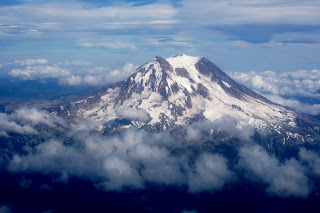August 24, 2016
This morning we awoke in the port of Sitka, the first
capital of Alaska. Sitka has a long pre-American history that we are going to explore.
After taking a shuttle into town, our first stop is Sitka National Historical
Park where we join a ranger walk. She teaches us about totem poles, an art
synonymous with the Indians native to the Alaskan peninsula.
An early governor of Alaska noticed these monumental tree
carvings were disappearing, so he started acquiring totem poles for display at the 1804 St. Louis World's Fair. Afterwards they were brought here. Our walk in the rain forest takes us past the collection. The meaning of the characters on totem poles
has been lost but archeologists believe they were carved either to tell a story
or delineate an ancestry. During the talk we stop several times to watch
bald eagles play in the trees above our heads. We end our walk at the Indian
River where we watch salmon spawning.
We then viewed the park movie where we learn the next phase
of Sitka history. The Russians discovered Alaska in 1741, and developed a
profitable trade in sea otter fur. They
built their capital here in Sitka, but not before having a war with
the local Tlingits. In 1867 with the sea otter nearly extinct, Alaska was sold
to the US. When Americans discovered
gold in Juneau, the capital was moved there, leaving Sitka a backwater.
From the park we visited the nearby Sheldon Jackson
Museum. It has an impressive collection
of Alaskan Indian artifacts. What we
find most interesting are the garments they made to protect themselves from the
extreme elements. Waterproof outfits
were made from sea lion intestines.
After a speedy tour our next stop was the Russian Bishop’s
House. The lower floor is a museum
where we learn more about the Russian history of Sitka. We take a ranger tour of the upper floor
where we step back in time to the Russian colonial period. The Park System did a great job restoring
the living quarters of this Orthodox Bishop whose diocese stretched from Alaska to the Kamchatka Peninsula in Asia.
His fine furnishings (e.g. English china, mahogany furniture) show world trade was brisk, and that even on the edge of civilization, one can live pretty well.

In the center of Sitka we stopped at St Michael’s Cathedral
with its distinctive green onion-domed roof and wood cladding. The missionary work of the Russian bishop was pretty successful, as the Tlingit remain Orthodox Christians to this day.
While Aimee
shops, I run down the street to climb Baranov Castle Hill State Historic
Site. This is where the Russians had
their main fortification and where they officially transferred ownership of
Alaska to the US.
Back on board for a late lunch, our ship set sail at
3:30. In the shallow waters off Baranov
Island we saw lots of Sea Otters playing and floating on their backs. We also saw whales! Humpbacks! Their characteristic blowhole
spray can be seen a mile off. Then we
waited for the tail to appear to start the next dive. We even saw a couple humpbacks breach the surface.
For dinner tonight we got prime seats by the stern
window.

















